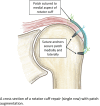Rotator Cuff Repair With Patch Augmentation: What Do We Know?
- PMID: 36452419
- PMCID: PMC9702027
- DOI: 10.22038/ABJS.2022.61345.3012
Rotator Cuff Repair With Patch Augmentation: What Do We Know?
Abstract
Background: Repair of massive rotator cuff tears remains a challenging process with mixed success. There is a growing interest in the use of patches to augment the repair construct and the potential to enhance the strength, healing, and associated clinical outcomes. Such patches may be synthetic, xenograft, or autograft/allograft, and a variety of techniques have been tried to biologically enhance their integration and performance. The materials used are rapidly advancing, as is our understanding of their effects on rotator cuff tissue. This article aims to evaluate what we currently know about patch augmentation through a comprehensive review of the available literature.
Methods: We explore the results of existing clinical trials for each graft type, new manufacturing methods, novel techniques for biological enhancement, and the histological and biomechanical impact of patch augmentation.
Results: There are promising results in short-term studies, which suggest that patch augmentation has great potential to improve the success rate. In particular, this appears to be true for human dermal allograft, while porcine dermal grafts and some synthetic grafts have also had promising results.
Conclusion: However, there remains a need for high-quality, prospective clinical trials directly comparing each type of graft and the effect that they have on the clinical and radiological outcomes of rotator cuff repair.
Keywords: Biological enhancement; Extracellular matrix; Patch augmentation; Rotator cuff; Rotator cuff repair; Rotator cuff tear; Tissue scaffolds.
Figures
Similar articles
-
Dermal Allograft Augmentation for Rotator Cuff Tears.Arthroscopy. 2022 Nov;38(11):2957-2959. doi: 10.1016/j.arthro.2022.08.004. Arthroscopy. 2022. PMID: 36344055
-
Effect of platelet-rich plasma and porcine dermal collagen graft augmentation for rotator cuff healing in a rabbit model.Am J Sports Med. 2013 Dec;41(12):2909-18. doi: 10.1177/0363546513503810. Epub 2013 Sep 18. Am J Sports Med. 2013. PMID: 24047553
-
Arthroscopic repair of posterosuperior rotator cuff tears with bioabsorbable patch augmentation: a magnetic resonance-controlled case series with 1-year follow-up.JSES Int. 2020 Sep 9;4(4):860-868. doi: 10.1016/j.jseint.2020.07.019. eCollection 2020 Dec. JSES Int. 2020. PMID: 33345226 Free PMC article.
-
Patch Augmentation in Arthroscopic Rotator Cuff Surgery-Review of Current Evidence and Newest Trends.J Clin Med. 2024 Aug 27;13(17):5066. doi: 10.3390/jcm13175066. J Clin Med. 2024. PMID: 39274280 Free PMC article. Review.
-
Biologics to Improve Healing in Large and Massive Rotator Cuff Tears: A Critical Review.Orthop Res Rev. 2020 Oct 13;12:151-160. doi: 10.2147/ORR.S260657. eCollection 2020. Orthop Res Rev. 2020. PMID: 33116954 Free PMC article. Review.
Cited by
-
Decellularized biological matrices for the repair of rotator cuff lesions: a systematic review of preclinical in vivo studies.Front Bioeng Biotechnol. 2024 Feb 1;12:1345343. doi: 10.3389/fbioe.2024.1345343. eCollection 2024. Front Bioeng Biotechnol. 2024. PMID: 38361793 Free PMC article.
-
Dermal Allograft Augmentation of Rotator Cuff Repair via the Arthroscopic Shoulder Kite Technique.Arthrosc Tech. 2024 Jul 26;13(12):103134. doi: 10.1016/j.eats.2024.103134. eCollection 2024 Dec. Arthrosc Tech. 2024. PMID: 39780871 Free PMC article.
-
A pilot randomised controlled trial assessing standard versus dermal patch-augmented rotator cuff repair found no adverse effects and suggest future trials need a minimum of 150 patients.Knee Surg Sports Traumatol Arthrosc. 2023 Jul;31(7):2654-2661. doi: 10.1007/s00167-023-07356-5. Epub 2023 Mar 2. Knee Surg Sports Traumatol Arthrosc. 2023. PMID: 36862197 Clinical Trial.
-
Role of ultrasound and MRI in the evaluation of postoperative rotator cuff.J Ultrason. 2023 Nov 23;23(95):e188-e201. doi: 10.15557/jou.2023.0028. eCollection 2023 Oct. J Ultrason. 2023. PMID: 38020508 Free PMC article.
-
Combination Effect of Rotator Cuff Repair with Secretome-hypoxia MSCs Ameliorates TNMD, RUNX2, and Healing Histology Score in Rotator Cuff Tear Rats.Arch Bone Jt Surg. 2023;11(10):617-624. doi: 10.22038/ABJS.2023.67933.3218. Arch Bone Jt Surg. 2023. PMID: 37873528 Free PMC article.
References
-
- Jost B, Pfirrmann CW, Gerber C, Switzerland Z. Clinical outcome after structural failure of rotator cuff repairs. J Bone Joint Surg Am. 2000;82(3):304–314. - PubMed
-
- Kim S-J, Choi Y-R, Jung M, Lee W, Chun Y-M. Arthroscopic Repair of Anterosuperior Massive Rotator Cuff Tears: Does Repair Integrity Affect Outcomes? Am J Sports Med. 2017;45(8):1762–1768. - PubMed
-
- Galatz LM, Ball CM, Teefey SA, Middleton WD, Yamaguchi K. The outcome and repair integrity of completely arthroscopically repaired large and massive rotator cuff tears. J Bone Joint Surg Am. 2004;86(2):219–224. - PubMed
Publication types
LinkOut - more resources
Full Text Sources



